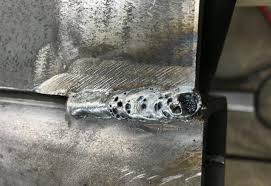The Science Behind Porosity: A Comprehensive Overview for Welders and Fabricators
Comprehending the intricate mechanisms behind porosity in welding is vital for welders and producers aiming for remarkable craftsmanship. From the make-up of the base products to the details of the welding process itself, a wide variety of variables conspire to either aggravate or minimize the existence of porosity.
Understanding Porosity in Welding
FIRST SENTENCE:
Exam of porosity in welding discloses essential understandings right into the stability and top quality of the weld joint. Porosity, defined by the existence of cavities or spaces within the weld steel, is a common worry in welding processes. These voids, if not correctly dealt with, can jeopardize the structural honesty and mechanical residential properties of the weld, leading to potential failings in the ended up item.

To find and quantify porosity, non-destructive screening techniques such as ultrasonic testing or X-ray inspection are typically used. These techniques permit the identification of inner issues without endangering the honesty of the weld. By examining the dimension, shape, and distribution of porosity within a weld, welders can make enlightened choices to enhance their welding processes and achieve sounder weld joints.

Factors Influencing Porosity Development
The event of porosity in welding is influenced by a myriad of elements, ranging from gas protecting performance to the details of welding parameter settings. Welding parameters, consisting of voltage, present, take a trip rate, and electrode type, additionally impact porosity development. The welding technique utilized, such as gas metal arc welding (GMAW) or shielded metal arc welding (SMAW), can influence porosity formation due to variations in warm circulation and gas protection - What is Porosity.
Impacts of Porosity on Weld Quality
Porosity formation significantly jeopardizes the structural stability and mechanical buildings of bonded joints. When porosity is present in a weld, it creates gaps or cavities within the product, lowering the overall strength of the joint. These gaps function as stress concentration points, making the weld a lot more prone to breaking and failing under load. The visibility of porosity also deteriorates the weld's resistance to corrosion, as the entraped air or gases within the gaps can respond with the surrounding setting, resulting in destruction over time. In addition, porosity can impede the weld's capability to withstand stress or impact, further jeopardizing the overall high quality and reliability of the welded framework. In vital applications such as aerospace, automobile, or architectural building and constructions, where security and durability are vital, the destructive results of porosity on weld high quality can have serious effects, emphasizing the importance of decreasing porosity through appropriate welding strategies and treatments.
Methods to Reduce Porosity
To enhance the high quality of bonded joints and ensure architectural stability, welders and makers employ certain techniques focused on minimizing the formation of gaps and tooth cavities within the product throughout the welding process. One reliable technique to lessen porosity is to guarantee correct product prep work. This includes extensive cleansing of the base metal to get rid of any type of impurities such as oil, grease, or dampness that could add to porosity development. Additionally, using the suitable welding specifications, such as the right voltage, existing, and take a trip rate, is important in stopping porosity. Keeping a constant arc length and angle during welding likewise aids minimize the possibility of porosity.

Utilizing the ideal welding technique, such as back-stepping or employing a weaving movement, can additionally assist distribute heat uniformly and minimize the chances of porosity formation. By carrying out these techniques, welders can properly decrease porosity and create high-grade welded joints.

Advanced Solutions for Porosity Control
Applying sophisticated innovations and ingenious methods plays a pivotal function in attaining superior control over porosity in welding processes. One sophisticated service is the use of discover this info here advanced gas blends. Shielding gases like helium or a combination of argon and hydrogen can help reduce porosity by supplying far better arc security and improved gas protection. In addition, utilizing advanced welding techniques such as pulsed MIG welding or changed environment welding can likewise help mitigate porosity problems.
One more sophisticated option involves the usage of advanced welding devices. Utilizing tools with built-in attributes like waveform control and sophisticated power resources can enhance weld quality and reduce porosity dangers. In addition, the execution of automated welding systems with precise control over specifications can dramatically minimize porosity flaws.
In addition, incorporating innovative tracking and examination innovations such as real-time X-ray imaging or automated ultrasonic screening can help in detecting porosity early in the welding procedure, permitting prompt corrective actions. In general, integrating these advanced services can considerably enhance porosity control and boost the general high quality of welded parts.
Final Thought
In conclusion, understanding the scientific research behind porosity in welding is vital for welders and fabricators to generate high-grade welds. By recognizing the aspects affecting porosity formation and applying methods to decrease it, welders can boost the total weld high quality. Advanced services for porosity control can further enhance the welding procedure and make certain a strong and reputable weld. It review is very why not find out more important for welders to continuously educate themselves on porosity and implement best methods to attain ideal results.